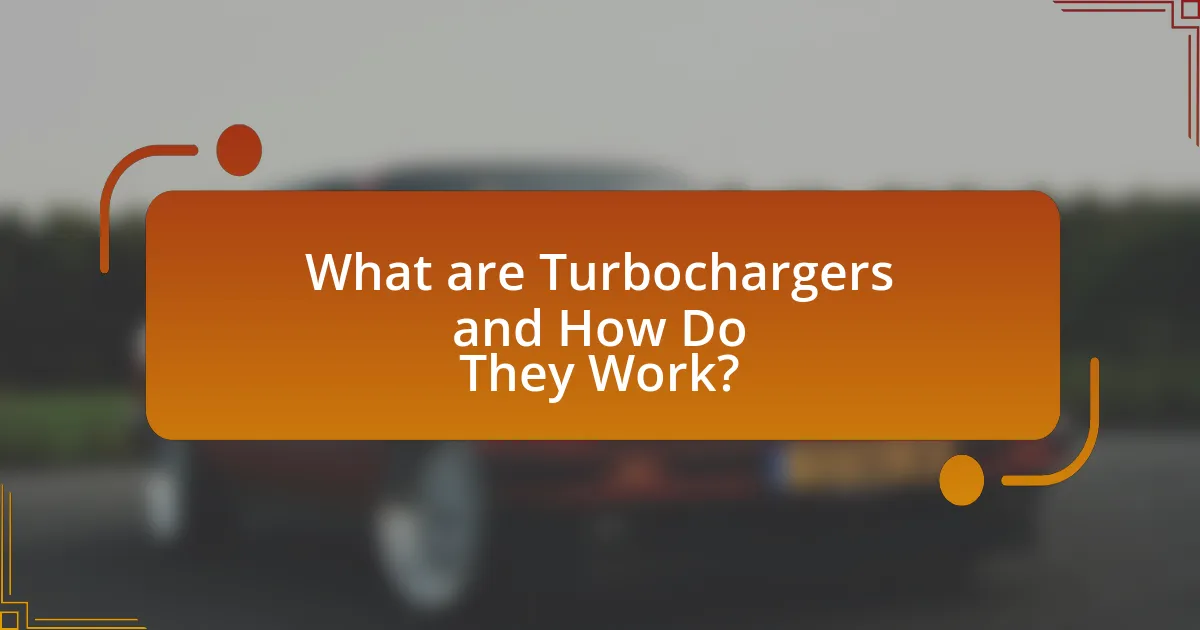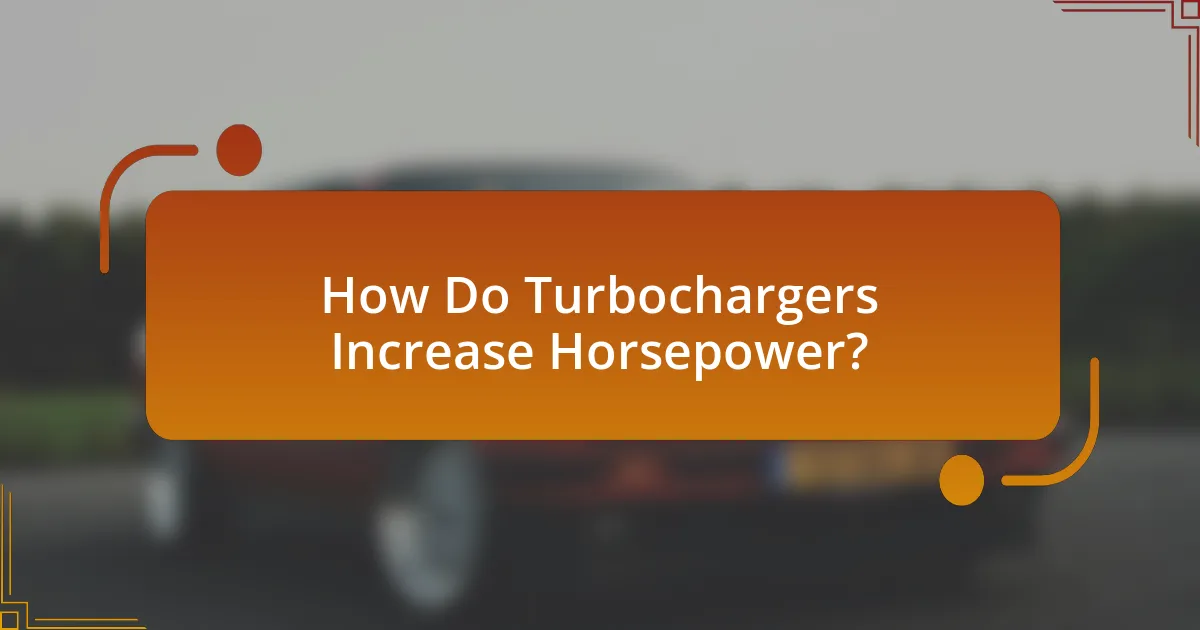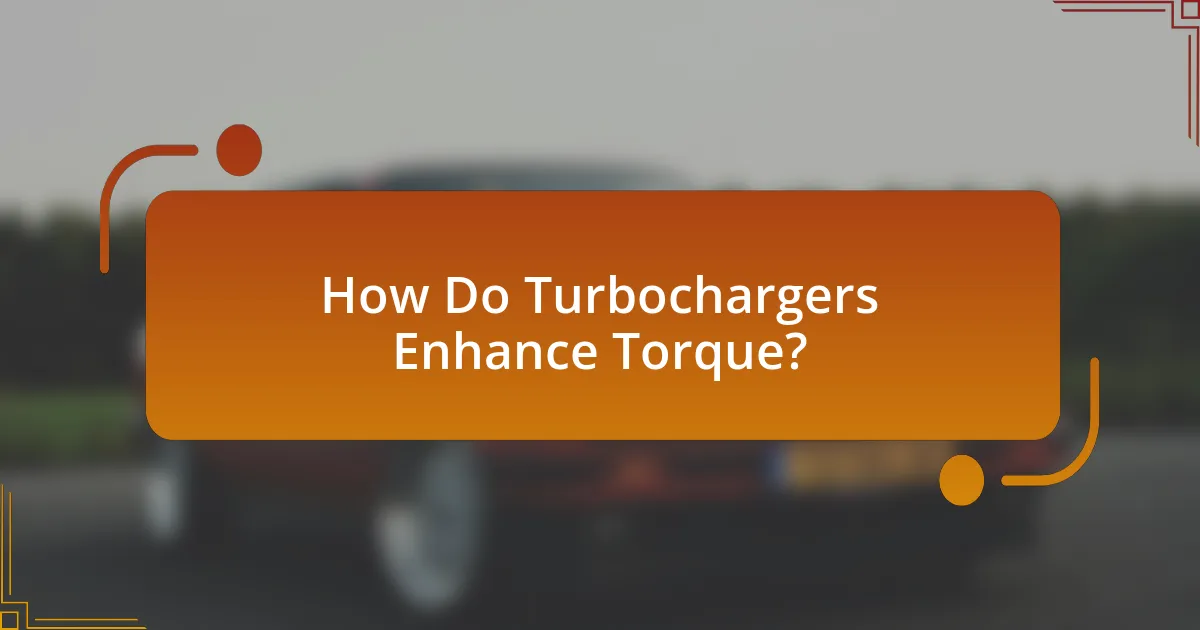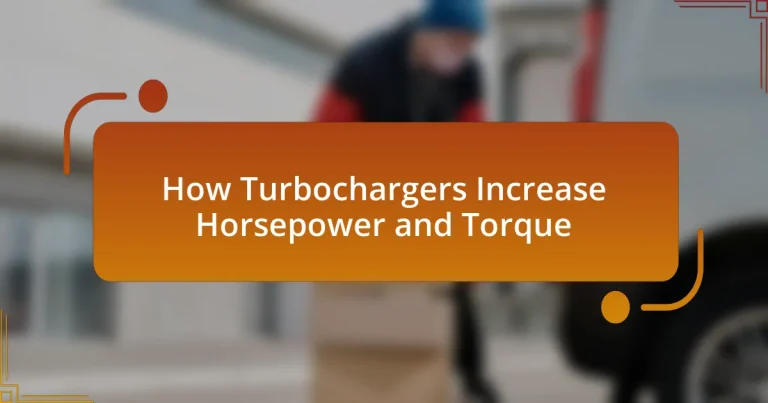Turbochargers are devices that enhance engine efficiency and power output by forcing more air into the combustion chamber, utilizing exhaust gases to spin a turbine that drives a compressor. This process allows for a greater volume of air and fuel to be combusted, resulting in increased horsepower and torque, with turbocharged engines achieving up to 30% more power compared to naturally aspirated engines. The article explores the main components of turbochargers, their design impact on performance, the role of forced induction in enhancing horsepower and torque, and the benefits of turbocharging in vehicles. Additionally, it addresses factors influencing turbocharger effectiveness, common challenges faced by turbocharged engines, and essential maintenance practices to ensure optimal performance.

What are Turbochargers and How Do They Work?
Turbochargers are devices that increase an engine’s efficiency and power output by forcing more air into the combustion chamber. They work by using exhaust gases to spin a turbine, which in turn drives a compressor that draws in and compresses ambient air before it enters the engine. This process allows for a greater volume of air and fuel to be combusted, resulting in increased horsepower and torque. The effectiveness of turbochargers is evidenced by their widespread use in both performance and fuel-efficient vehicles, demonstrating their ability to enhance engine performance without significantly increasing engine size.
How does a turbocharger increase engine efficiency?
A turbocharger increases engine efficiency by forcing more air into the combustion chamber, allowing for more fuel to be burned. This process enhances the engine’s power output without significantly increasing its size or weight. By utilizing exhaust gases to spin a turbine, the turbocharger compresses incoming air, which increases its density and oxygen content. This results in a more complete combustion process, leading to improved fuel efficiency and power generation. Studies show that turbocharged engines can achieve up to 20-30% better fuel efficiency compared to naturally aspirated engines under similar conditions.
What are the main components of a turbocharger?
The main components of a turbocharger are the turbine, compressor, and center housing. The turbine converts exhaust gases into rotational energy, while the compressor draws in and compresses air before it enters the engine. The center housing contains the bearings and supports both the turbine and compressor, allowing them to rotate efficiently. These components work together to increase the engine’s air intake, thereby enhancing horsepower and torque.
How does the turbocharger’s design affect performance?
The turbocharger’s design significantly affects performance by influencing airflow, pressure, and efficiency. A well-designed turbocharger optimizes the intake of exhaust gases, which enhances the turbine’s ability to spin and compress air into the engine. This increased air density allows for more fuel to be burned, resulting in higher horsepower and torque output. For example, a larger compressor wheel can move more air, while a smaller turbine can spool up faster, improving throttle response. Studies have shown that specific design features, such as the geometry of the turbine and compressor, can lead to performance gains of 20-30% in horsepower compared to naturally aspirated engines.
What role does forced induction play in horsepower and torque?
Forced induction significantly increases horsepower and torque by forcing more air into the engine’s combustion chamber, allowing for more fuel to be burned. This process enhances the engine’s efficiency and power output, as seen in turbocharged engines that can produce up to 70% more horsepower compared to naturally aspirated engines of similar size. The increased air density from forced induction leads to a higher mass flow rate, resulting in improved combustion and, consequently, greater torque at lower RPMs. This is evidenced by the performance metrics of vehicles equipped with turbochargers, which often demonstrate substantial gains in both horsepower and torque across a broader range of engine speeds.
How does forced induction differ from naturally aspirated engines?
Forced induction engines utilize a mechanism, such as a turbocharger or supercharger, to compress air entering the engine, thereby increasing the amount of oxygen available for combustion, which enhances power output. In contrast, naturally aspirated engines rely solely on atmospheric pressure to draw air into the combustion chamber, limiting their power potential due to lower air density at higher engine speeds. The difference in air intake methods results in forced induction engines typically producing more horsepower and torque compared to naturally aspirated engines, as evidenced by the fact that turbocharged engines can achieve up to 30% more power than their naturally aspirated counterparts under similar conditions.
What are the benefits of using forced induction in vehicles?
The benefits of using forced induction in vehicles include increased horsepower and torque, improved engine efficiency, and enhanced performance without significantly increasing engine size. Forced induction systems, such as turbochargers and superchargers, compress the intake air, allowing for more air and fuel to enter the engine, which results in a more powerful combustion process. For instance, turbocharged engines can produce up to 30% more power compared to naturally aspirated engines of the same size, demonstrating the effectiveness of forced induction in maximizing engine output while maintaining fuel efficiency.

How Do Turbochargers Increase Horsepower?
Turbochargers increase horsepower by forcing more air into the engine’s combustion chamber, allowing for more fuel to be burned. This process enhances the engine’s efficiency and power output. Specifically, a turbocharger uses exhaust gases to spin a turbine, which then compresses incoming air, increasing its density. This denser air-fuel mixture leads to a more powerful combustion process, resulting in higher horsepower. For example, a turbocharged engine can produce up to 30% more horsepower compared to a naturally aspirated engine of the same size, demonstrating the significant impact of forced induction on engine performance.
What is the relationship between turbochargers and horsepower?
Turbochargers significantly increase horsepower by forcing more air into the engine, allowing for more fuel to be burned and thus generating more power. This process enhances the engine’s efficiency and performance, as turbochargers utilize exhaust gases to spin a turbine, which compresses incoming air. For example, a turbocharged engine can produce up to 30% more horsepower compared to a naturally aspirated engine of the same size, demonstrating the direct correlation between turbocharging and increased horsepower.
How does increased air intake contribute to horsepower gains?
Increased air intake contributes to horsepower gains by allowing the engine to burn more fuel, which results in greater power output. When an engine receives more air, it can mix a larger volume of fuel with that air, leading to a more efficient combustion process. This is particularly important in turbocharged engines, where forced induction increases the amount of air entering the combustion chamber. Studies have shown that for every 10% increase in air intake, there can be a corresponding increase in horsepower, as the engine can produce more power due to the enhanced combustion efficiency.
What is the impact of turbo boost on engine output?
Turbo boost significantly increases engine output by forcing more air into the combustion chamber, allowing for more fuel to be burned. This process enhances the engine’s power and efficiency, leading to higher horsepower and torque. For example, a turbocharger can increase an engine’s output by 30% to 50% or more, depending on the design and application. This increase is due to the turbocharger compressing the intake air, which raises the air density and improves combustion efficiency, resulting in greater power generation.
What factors influence the effectiveness of a turbocharger in increasing horsepower?
The effectiveness of a turbocharger in increasing horsepower is influenced by several key factors, including boost pressure, engine displacement, air-fuel mixture, and exhaust flow. Boost pressure directly correlates with the amount of compressed air forced into the engine, which enhances combustion efficiency and power output. Engine displacement affects how much air and fuel can be processed, with larger engines typically benefiting more from turbocharging. The optimal air-fuel mixture ensures complete combustion, maximizing energy extraction from the fuel. Additionally, efficient exhaust flow is crucial, as it allows the turbocharger to spool up quickly and maintain boost levels, thereby improving overall performance. These factors collectively determine how effectively a turbocharger can enhance horsepower in an engine.
How do engine size and design affect turbocharger performance?
Engine size and design significantly influence turbocharger performance by determining the volume of air and fuel that can be efficiently processed. Larger engines typically provide more displacement, allowing for greater airflow, which enhances the turbocharger’s ability to compress air and increase power output. Additionally, the design of the engine, including factors like cylinder head configuration and intake manifold design, affects how effectively the turbocharger can spool up and deliver boost. For instance, engines with optimized airflow paths and lower restrictions can achieve quicker spool times, resulting in improved throttle response and overall performance.
What is the significance of turbo lag in horsepower delivery?
Turbo lag significantly affects horsepower delivery by creating a delay between the driver’s throttle input and the turbocharger’s response. This lag occurs because the turbocharger requires time to spool up and generate boost pressure, which is essential for increasing engine power. During this period, the engine may not deliver the expected horsepower, leading to a temporary reduction in acceleration. Studies have shown that turbo lag can vary based on factors such as turbocharger size, engine design, and tuning, with smaller turbos typically providing quicker response times. Therefore, understanding and mitigating turbo lag is crucial for optimizing horsepower delivery in turbocharged engines.

How Do Turbochargers Enhance Torque?
Turbochargers enhance torque by forcing more air into the engine’s combustion chamber, allowing for a greater fuel-air mixture and more powerful combustion. This increase in air density leads to improved engine efficiency and performance, resulting in higher torque output. For example, a turbocharger can increase an engine’s torque by up to 40% or more, depending on the specific application and design. This is achieved through the turbocharger’s turbine, which utilizes exhaust gases to spin a compressor that draws in additional air, effectively increasing the engine’s power without significantly increasing its size or weight.
What is torque and why is it important for vehicle performance?
Torque is a measure of rotational force applied to an object, typically expressed in pound-feet or Newton-meters. In vehicle performance, torque is crucial because it directly influences acceleration and the ability to move heavy loads. Higher torque allows a vehicle to accelerate faster from a standstill and maintain speed more effectively, especially when climbing hills or towing. For example, engines designed with turbochargers often produce increased torque at lower RPMs, enhancing overall performance and responsiveness. This characteristic is essential for achieving optimal power delivery and driving dynamics, making torque a key factor in a vehicle’s capability and efficiency.
How does a turbocharger affect torque output in an engine?
A turbocharger increases torque output in an engine by forcing more air into the combustion chamber, allowing for more fuel to be burned. This process enhances the engine’s efficiency and power, particularly at lower RPMs, where turbochargers can significantly improve torque delivery. For example, a study by the Society of Automotive Engineers found that turbocharged engines can produce up to 30% more torque compared to naturally aspirated engines of similar size, demonstrating the effectiveness of turbocharging in enhancing engine performance.
What are the advantages of increased torque for driving experience?
Increased torque enhances the driving experience by providing greater acceleration and improved responsiveness. Vehicles with higher torque can achieve faster speeds from a standstill, allowing for quicker merges and overtaking maneuvers. This is particularly beneficial in situations requiring immediate power, such as climbing hills or carrying heavy loads. Additionally, increased torque contributes to a smoother driving experience, as it allows for more efficient power delivery across a wider range of engine speeds. This results in less gear shifting and a more relaxed driving style, especially in stop-and-go traffic.
How does turbocharger sizing impact torque delivery?
Turbocharger sizing directly impacts torque delivery by influencing the engine’s ability to produce boost at various RPMs. A properly sized turbocharger ensures optimal airflow and pressure, which enhances the engine’s torque output, particularly in the mid to low RPM range where turbo lag can be a concern. For instance, a smaller turbocharger can spool up quickly, providing immediate torque, while a larger turbocharger may take longer to reach peak boost but can deliver higher torque at higher RPMs. This relationship is crucial because it determines how effectively the engine can utilize the available air-fuel mixture to generate power, ultimately affecting vehicle performance.
What is the relationship between turbocharger size and low-end torque?
Turbocharger size directly influences low-end torque, with smaller turbochargers typically providing better low-end torque due to quicker spool times. Smaller turbos can reach their boost threshold at lower engine RPMs, enhancing responsiveness and delivering power sooner in the rev range. In contrast, larger turbochargers may produce higher peak power but often result in turbo lag, delaying the onset of boost and reducing low-end torque. This relationship is supported by engine tuning principles, where optimal turbo sizing is crucial for achieving desired torque characteristics across the RPM spectrum.
How can tuning affect torque characteristics in turbocharged engines?
Tuning can significantly enhance torque characteristics in turbocharged engines by optimizing air-fuel ratios, ignition timing, and boost levels. When tuning is performed, adjustments to the engine management system can lead to improved combustion efficiency, which directly increases torque output across various RPM ranges. For instance, a study by the Society of Automotive Engineers found that recalibrating the engine control unit (ECU) can yield torque gains of up to 20% in certain turbocharged applications. This is achieved by allowing the engine to produce more power at lower RPMs, thereby enhancing drivability and responsiveness.
What are the common challenges and solutions for turbocharged engines?
Turbocharged engines face several common challenges, including turbo lag, heat management, and engine knock. Turbo lag occurs due to the time taken for the turbocharger to spool up, which can lead to delayed power delivery. Solutions include using twin-scroll turbos or variable geometry turbos that improve responsiveness. Heat management is critical, as turbochargers generate significant heat, which can lead to component failure. Implementing better intercooling systems and heat-resistant materials can mitigate this issue. Engine knock, caused by pre-ignition due to high cylinder temperatures and pressures, can be addressed by using higher-octane fuels and optimizing engine tuning to reduce compression ratios. These solutions enhance performance and reliability in turbocharged engines.
How can overheating be managed in turbocharged systems?
Overheating in turbocharged systems can be managed through effective cooling strategies and proper maintenance. Implementing an efficient intercooler reduces the temperature of the compressed air before it enters the engine, thereby preventing excessive heat buildup. Additionally, using high-quality engine oil with a suitable viscosity helps maintain optimal lubrication and cooling of the turbocharger components. Regularly monitoring and maintaining the cooling system, including coolant levels and radiator efficiency, is crucial for preventing overheating. Studies indicate that maintaining optimal operating temperatures can enhance performance and longevity of turbocharged engines, as excessive heat can lead to component failure and reduced efficiency.
What maintenance practices are essential for turbocharged engines?
Essential maintenance practices for turbocharged engines include regular oil changes, monitoring coolant levels, and ensuring proper air intake. Regular oil changes are crucial because turbochargers operate at high temperatures and speeds, requiring clean oil to prevent wear and tear. Monitoring coolant levels helps maintain optimal operating temperatures, preventing overheating, which can damage the turbocharger. Ensuring proper air intake is vital for efficient combustion and performance, as a clogged air filter can restrict airflow, negatively impacting engine efficiency. These practices are supported by automotive engineering principles that emphasize the importance of lubrication, temperature control, and airflow in maintaining engine performance and longevity.


